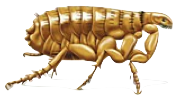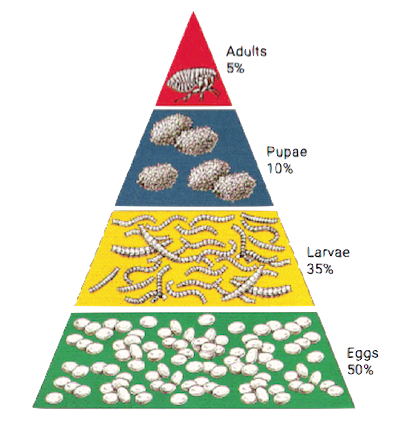Educational Resources
Flea Control for Cats

Flea Life Cycle
The life cycle of a flea can be completed in as few as 17 days. An adult female flea lays hundreds of eggs that are designed to fall off the host (cat) and into the environment. The cat spreads these eggs throughout the house as it moves and scratches. Fleas may also lay eggs in the bottom layer of carpeting where it is cool and dark. The eggs normally hatch into larvae after 2–12 days. The larvae molt twice and then spin themselves into a cocoon where they pupate into adult fleas. The pupae can remain in these cocoons for many months before they emerge as adult fleas. Adult fleas may survive a few days without finding a host, but once one is found, they began taking blood meals immediately.

Flea Control
It is estimated that the fleas an owner sees on the pet represent 1–5% of the fleas in the environment. That means that 95–99% of the fleas in a home are NOT on the pet, but in the carpeting, bedding, and upholstery.
Therefore, treatments that focus on controlling all life stages of the flea, whether they occur on or off the host, are essential for the effective elimination of flea infestation.
Flea control is so important in cats because fleas can cause a severe allergic skin reaction. In fact, it is the most common allergic response we see in cats.
Cats are extremely sensitive to medications. Some older forms of flea medications that are sold over-the-counter are insecticide-based and may pose a risk to your cat. Newer products, some of which are now available without a prescription, have been designed so that they target only the flea and its various life stages. These medications are considered safe for use in cats.
** Use only products labeled for cats! Formulations labeled for dogs often contain levels of medication that are toxic for cats. **
Available and Safe Flea Control Products
Revolution (selamectin)
A topical parasiticide is applied to the skin and is effective for 30 days. Selamectin kills adult fleas and larva and prevents flea eggs from hatching by attacking the flea’s nervous system. It is also used to treat ear mites and roundworms and as a heartworm preventative. Revolution is FDA-approved, meaning it has passed more stringent safety guidelines. Revolution is alcohol-based and formulations are available for cats 8 weeks and older. This is a prescription medication. We highly recommend this product for cats that go outdoors because it prevents a variety of internal and external parasite infections.
Cheristin (spinetoram)
A novel compound, spinetoram targets fleas' nervous system resulting in paralysis and rapid death. In fact, within 6–12 hours, at least 98.8% of live fleas are killed. A topical parasiticide, the medicine is distributed over the entire body and once dry is not affected by sun or water exposure. In addition to being effective and safe, this product features a very easy applicator tip and is available over-the-counter.
Flea Control Products that ARE NOT Recommended:
Over-the-counter (OTC) shampoos, dips, and collars
(Hartz, Sergeants, Bio-Spot, Kirkland): Contain permethrin insecticides which may be toxic to cats. These products kill adult fleas on the cat and have little residual activity.
Natural flea remedies
Essential oils (Tea Tree, Cedar, Eucalyptus, Citronella, Peppermint, Neem, Limonene): Cats do not metabolize essential oils effectively, so the application of oils through collars or spot-on products may cause toxicity. All essential oils are potentially toxic in cats. Symptoms of toxicity include lethargy, decreased appetite, vomiting, and dizziness.
Foggers
Typically contain permethrin or pyrethrin insecticides. These products have little residual activity and require humans and animals to be removed from the environment during treatment and for a period after application.
Environmental Control
In many cases of flea infestation, environmental management may also be necessary. It takes up to 3-months to break the life cycle of the flea, so treating all pets monthly and cleaning the environment is recommended.
Vacuuming
A study conducted by The Ohio State University demonstrated that up to 96% of adults and all immature stages of fleas can be killed by vacuuming. Vacuuming should be performed on carpeted as well as wooden floors and along with the floorboard twice weekly.
Wash Pet Bedding
FleaGo
A borax salt crystal, FleaGo functions as a desiccant, meaning it dehydrates the environment making it inhospitable for fleas. The product is applied to carpet and upholstery. It requires approximately 2–4 weeks to kill all fleas
Vet-Kem Flea Spray
This is a spray that contains permethrins and pyriproxyfen. Because it is a permethrin insecticide, all animals should be removed from the area prior to application and should remain away until the area is dry. Humans and animals should not come in contact with treated surfaces until the spray has dried. Because cats often groom their paws, it is possible for them to ingest the product if they walk in a wet area and then groom. Do not apply directly to the animal. Permethrins are also light-sensitive and will degrade upon exposure to direct sunlight. Therefore, application in sunlight rooms may not be effective.
Diatomaceous Earth
A non-toxic product that kills fleas by damaging their exoskeleton. It is a fine powder that is applied along floorboards, doors, and windows and in carpets.
NOTE: People or animals with asthma should not be exposed to Diatomaceous Earth because the fine particular can be easily inhaled and cause airway irritation.
Please ask any of our staff if you have questions or need help locating a product.



